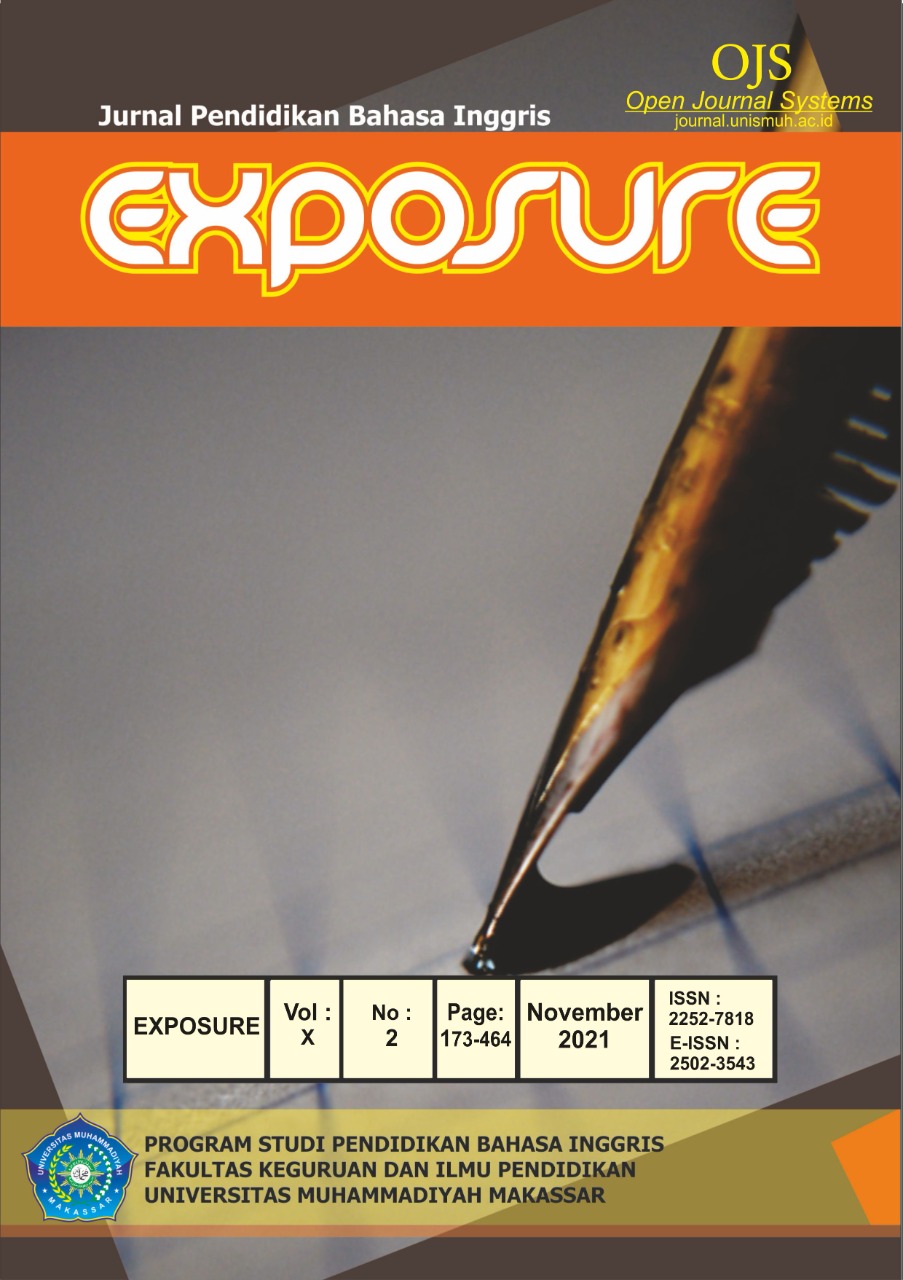STUDENTS’ PERCEPTIONS TOWARDS DIGITAL TEXT READING
DOI:
https://doi.org/10.26618/exposure.v10i2.6091Keywords:
Keywords, Students’ Perception, Digital Text Reading, Reading Comprehension AchievementAbstract
ABSTRACT
This research is a survey research in line with finding out the dominant perceptions of UPT students of SMA Negeri 7 Ogan Ilir towards Digital Text Reading. The samples of the research were 87 students, 44 tenth graders and 43 eleventh graders. The researchers used collect the data. To analyze the data, the researchers used percentage analysis. The results showed that the students had positive perception towards digital text reading in their daily life. They often learn and do assignment using digital media because it gives positive experience,motivation and improve reading comprehension achievement. In conclusion, It is comfortable, flexible and helpful to search relevant additional text to study
References
REFERENCES
Alizamar., Couto, N. (2016). Psikologi persepsi dan desain informasi. Yogyakarta: Media Akademi
Amberg, J., Deborah. (2009). What is language. American English: History, Structure, and Usage.Retrievedfromhttp://www.academia.edu/7153862/Introduction_What_is_language
Bana, A. (2020).Students' perception of using the internet to develop reading habits: A Case Study at the English Education Department of Universitas Kristen Indonesia. Journal of English Teaching 6(1), 60-70
Chettri, K., & Rout, S.K. (2013). Reading habits: An overview. IOSR Journal of Humanities and Social Science (IOSR-JHSS) 14(1), 13-17.
Ebrahimi, S.( 2016).Effect of digital reading on comprehension of english prose texts in efl/esl contexts. International Journal of English Language and Literature Studies, 2016, 5(2), 111-117
Frankel, K. (2016). What is reading: Journal of education 196(2), 7-17
Hwang, Hwang C, Pomplun. (2011). Semantic guidance of eye movements in real-world scenes. Vision Research, 51(10), 1192–1205
Liu, Z. (2012). "Digital reading" Chinese Journal of Library and Information Science (English edition), 5 (1), 85-94
Manalu, B. (2019). Students’ perception of digital texts reading: A case study at the english education department of Universitas Kristen Indonesia. Journal of English Teaching 5(3), 191-203
Nowak, L.(2008). Digital reading theory and its relationship to academic reading practices. Design of Electronic Text 1(1), 1-7
Otara, A. (2011). Perception: a guide for managers and leaders. Journal of Management and Strategy 2(3), 21-24
Roopa, S., Rani, M.S. (2010). Questionnaire disigning for a survey. The Journal of Indian Orthodontic Society 46(4): 273-277
Sudijono, A. (2017). Pengantar statistik pendidikan. Jakarta: Raja Grafindo Persada.
Sulaiman, M.G.S. (2017). Teach the students not the books: A Handbook of TEFL (1sted). Palembang: Noerfikri Offset.
Syahri, I., Sulaiman, M.G.S., Susanti, R.(2017). Metodologi penelitian pendidikan bahasa. Palembang: Roemah Sufie.
vandenhoek.(2013).Screen reading habits among university students. International Journal of Education and Development using Information and Communication Technology (IJEDICT), 9(2), 37-47
Wang, Y. (2007). On the cognitive processes of human perception with emotions, motivations, and attitudes. International Journal of Cognitive Informatics and Natural Intelligence, 1(4), 1–13,
Yang, Z.(2014).Effective method in improving reading skill in English study. Journal International Conference on Education, Language, Art and Intercultural Communication (ICELAIC 2014), 284-286
Downloads
Additional Files
Published
Issue
Section
License
Authors who publish with this journal agree to the following terms:
In order to assure the highest standards for published articles, a peer review policy is applied. In pursue of the compliance with academic standards, all parties involved in the publishing process (the authors, the editors and the editorial board and the reviewers) agree to meet the responsibilities stated below in accordance to the Journal publication ethics and malpractice statement.
Duties of Authors:
- The author(s) warrant that the submitted article is an original work, which has not been previously published, and that they have obtained an agreement from any co-author(s) prior to the manuscript’s submission;
- The author(s) should not submit articles describing essentially the same research to more than one journal;
- The authors(s) make certain that the manuscript meets the terms of the Manuscript Submission Guideline regarding appropriate academic citation and that no copyright infringement occurs;
- The authors(s) should inform the editors about any conflict of interests and report any errors they subsequently, discover in their manuscript.
Duties of Editors and the Editorial Board:
- The editors, together with the editorial board, are responsible for deciding upon the publication or rejection of the submitted manuscripts based only on their originality, significance, and relevance to the domains of the journal;
- The editors evaluate the manuscripts compliance with academic criteria, the domains of the journal and the guidelines;
- The editors must at all times respect the confidentiality of any information pertaining to the submitted manuscripts;
- The editors assign the review of each manuscript to two reviewers chosen according to their domains of expertise. The editors must take into account any conflict of interest reported by the authors and the reviewers.
- The editors must ensure that the comments and recommendations of the reviewers are sent to the author(s) in due time and that the manuscripts are returned to the editors, who take the final decision to publish them or not.
Authors are permitted and encouraged to post online a pre-publication manuscript (but not the Publisher’s final formatted PDF version of the Work) in institutional repositories or on their Websites prior to and during the submission process, as it can lead to productive exchanges, as well as earlier and greater citation of published work (see The Effect of Open Access). Any such posting made before acceptance and publication of the Work shall be updated upon publication to include a reference to the Publisher-assigned DOI (Digital Object Identifier) and a link to the online abstract for the final published Work in the Journal.

